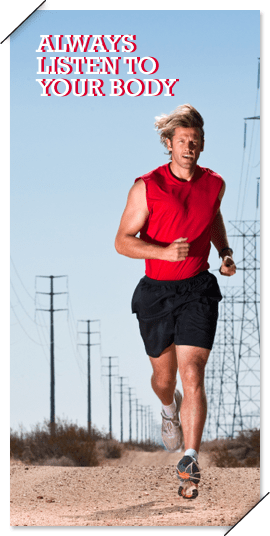Always be sure to stretch, but not before running, as stretching 'cold' can damage your muscles. Stretch during and after your run. Run easily for about 5-10 minutes, then stretch once you are warm and your muscles and joints are more pliable. Also, stretch your calves after your run.
Make sure you have the right running shoes. Technology improves constantly, and when looking for the right shoe, it‘s smart to go to a running shop where they will make sure you get shoes that fit and provide the biomechanical support you need. Knowing how to look after your foot when it hits the road makes a huge difference. If you have problem feet, ask your doctor for orthotics (shoe inserts) to help prevent injuries. And remember to replace your shoes often.
You probably have your own running technique. Even if details don’t really matter that much here, experts agree that you should run tall (not slouched) and straight (not leaning far forward or backward). Don‘t over-stride – that could put extra strain on your knees. Let your arms relax and find a natural, comfortable stride.
Have you skipped or missed more than a few days of training? Then go back to your pace of the previous week. If you have been sick, return to the pace of the previous two weeks. If you‘ve been injured, it‘s better to come back slowly, and protect the affected areas such as knees or ankles with stabilising braces. See the Elastoplast range for smart solutions.
Alternating running with walking doesn’t make you a loser – it’s a recommended technique to get back into your routine. It’s also fine to switch to walking once you have reached the point of fatigue or discomfort. Embrace walking as part of an overall run/walk strategy for completing long runs, or as a cross-training activity for non-running days in your training schedule.
Yes, running can in some cases lead to (mostly minor) injuries, but most can be prevented if you warm up, avoid doing too much too soon and wear the right running shoes. Before you start again, try some workouts designed to strengthen running-specific muscles to build endurance and prevent injuries.
Be sure to run with your mobile phone at hand, so that you can call someone in case of injury. Also, most smartphones support free apps that will help you set goals, track your route, your heartbeat, speed, pulse, calorie consumption and performance.







